Lebensreform
© Copyright Peter Crawford 2013
Lebensreform ("life reform") was a social movement in late 19th-century
and early 20th-century Germany, Austria and Switzerland that propagated
a back-to-nature lifestyle, emphasizing among others health food/raw
food/organic food, nudism, sexual liberation, alternative medicine, and
religious reform and at the same time abstention from alcohol, tobacco,
drugs, and vaccines.
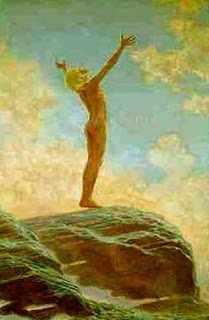 |
'Gebet
zum Licht'
Fidus (Hugo Höppener) |
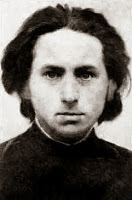 |
| Fidus
(Hugo Höppener) |
Important Lebensreform proponents were Sebastian Kneipp, Louis Kuhne,
Rudolf Steiner, Karl Wilhelm Diefenbach, Fidus (Hugo Höppener), Gusto
Graeser, and Adolf Just. Hugo Höppener (1868-1948), who used the pseudonym Fidus was one of the
most significant artists of the movement. Depicting nude figures among the natural landscape, not sexualized, but
in harmony with nature, and working in cooperation with each other,
Fidus gained wide recognition. Several of his works show a male-female
couple embracing, not out of lust, but in a kind of Tantric reaching
for Deity. His most famous work (of which he made several versions), 'Gebet zum
Licht' (Prayer to the Light), shows a man standing on a rock mound,
with his arms outstretched to the sky. In 1932, Fidus joined the NSDAP.. Fidus was probably impressed by the
National Socialist’s environmentalism and romantic portrayals of the
German people.
Ideology
in Germany
The Lebensreform movement in Germany originally was a politically
diverse movement. There were hundreds of groups across Germany dedicated to some of all
of the concepts associated with Lebensreform: ecology and organic
farming, vegetarianism, naturalism (Nacktkultur), and abstinence from
alcohol and tobacco. Dozens of magazines, books, and pamphlets were published on these
topics. Some groups were made of socialists, some were apolitical, and some
were right-wing and nationalist in outlook. One outstanding prophet of Lebensreform was the painter Karl Wilhelm
Diefenbach (1861-1913), pacifist and tolstoyan anarchist who founded
the community Himmelhof near Vienna.
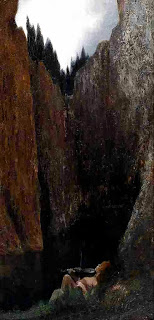 |
Geige
spielender Knabe
Karl Wilhelm Diefenbach |
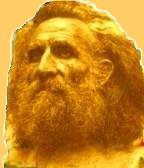 |
| Karl
Wilhelm Diefenbach |
Karl Wilhelm
Diefenbach (February 21, 1851, Hadamar, Duchy of Nassau – December 15,
1913, Capri) was a German painter and social reformer. Diefenbach was a
pioneer of nudism and the peace movement. His country commune in Vienna
(1897–1899) was one of the models for the reform settlement Monte
Verità in Ascona. His ideas included life in harmony with nature and
rejection of monogamy, turning away from any religion (although he was
a follower of theosophy, and a vegetarian diet. One of his students was
the artist Konstantinos Parthenis. As a painter he was
an independent representative of Art Nouveau and Symbolism.
Among his disciples were three painters: Fidus, Frantischek Kupka and
Gusto Graeser. In 1900 Graeser became the co-founder and inspiring pioneer of the
community Monte Verità near Ascona, Switzerland. Monte Verità attracted
lots of artists from all of Europe, during World War I conscientious
objectors from Germany and France.
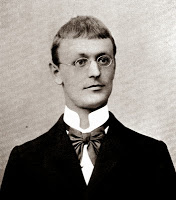 |
| Hermann
Hesse |
Gusto
Graeser, thinker and poet, greatly influenced the German Youth
Movement, and such writers as Hermann Hesse and Gerhart Hauptmann. He
was the model for the master figures in the books of Hermann Hesse. An
important influence on Völkisch ideology was Ludwig
Fahrenkrog (20 October 1867 – 27 October 1952) who was a German writer,
playwright and artist. He was born in Rendsburg, Prussia, in 1867. He
started his career as an artist in his youth, and attended the
Berlin Royal Art Academy before being appointed a professor in 1913. He
taught at the School of Arts and Crafts in Bremen from 1898 to 1931. He
was also involved in the founding of a series of
Völkisch groups in the early 20th century. The first group started
by Fahrenkrog was the 'Deutscher Bund für
Persönlichkeitskultur' (German League for the Culture of the
Personality), which also supported a publication called Mehr Licht!
("More Light!", the famous last words of Goethe).
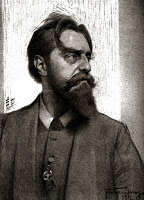 |
| Ludwig
Fahrenkrog |
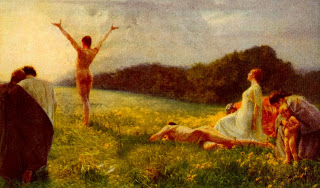 |
| Ludwig
Fahrenkrog - The Holy Hour (Die heilige Stunde), 1918 |
He was also involved with the 'Deutsche Religionsgemeinschaft' (German
Religious Community [DRG]), which would later change its name several
times, first in 1912 to Germanische-Deutsche Religionsgemeinschaft
(Germanic-German Religious Community [GDRG]), then in 1915, following a
split in the membership, to the Deutschgläubige Gemeinschaft
(Association of the German Faithful [DGG]).
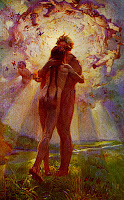 |
Earth
and the Sun Heaven and Earth, Baldur and Gerda
(Erde und Sonne, Himmel und Erde, Baldur und Gerda), 1921
Ludwig Fahrenkrog |
Other groups which emerged from völkisch Romanticism gradually became
part of National Socialist ideology by the 1930s, known as 'Blut und
Boden' (blood and soil).
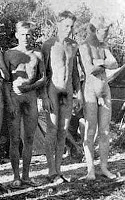 |
| Nacktheit
und Kultur |
As early as 1907, Richard Ungewitter published a pamphlet called
'Nacktheit und Kultur' (Nudity and Culture) (which sold 100,000
copies), arguing that the practices he recommended would be:
"the means by which the German race would regenerate itself and
ultimately prevail over its neighbours and the diabolical Jews, who
were intent on injecting putrefying agents into the nation's blood and
soil".
The most significant of these Lebensreform movements was
the Wandervogel.
 For an
understanding of the wider historic and social context and further
movements at the end of the 19th and in the first half of the 20th
century, see:
|